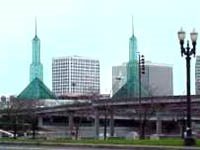
Portland (OR) has $5.8 billion in infrastructure facilities dedicated to transportation, but the Rose City's best assets are ones Tacoma can not only emulate, but duplicate--strong leaders committed to a common vision for how those assets may be best deployed.
Members of Tacoma's City Council on Friday heard from two of Portland's top transportation leaders during their visit to examine that system: Sam Adams and Rick Williams.
Sam AdamsUnder Portland's unique structure of government, wherein each elected official is a full-time professional serving with a specific portfolio, Commissioner Sam Adams is responsible for transportation, sewers--and arts & culture. The local transportation system, as he describes it, is innovative but badly mismatched with funding; Oregon's gas tax has not increased since 1991.
Adams calls pay stations, which Portland has deployed in three urban neighborhoods, a "counterintuitive demand factor"--it seems illogical that putting barriers in front of customers and clients would stimulate, not injure, business traffic and profits. While parking congestion is the sign of a viable neighborhood, Adams contends, too much congestion means lost revenue, so forcing turnover brings more dollars into a business district. "It's a real step off the gangplank for businesses," he admits, "...[but] if you study it well and use it where there's enough demand, you'll see the turnover--[and] more money coming into businesses."
Neighborhood benefit funding, Adams contends, turns the potential negative (what he calls the "gotcha" style of enforcement) into a positive--97% of users at Portland's
SmartMeters are self-policing. Merchants can set up a validation program using "smart cards" that can be funded out of neighborhood parking benefit program funds. The Rose City--like Old Pasadena--gives half the revenues beyond expenses of the program to merchants for marketing and beautification, as well as to increase off street parking, boosting their district's competitiveness. Shoppers seem to like the flexibility of the system, particularly that they can purchase time, not just lease a specific space.
Parking "gets the least amount of attention [of any transportation element] but requires the greatest amount of visioning," Adams notes, but offers opportunities for enhancement because "it's subject to numerical analysis." New technology makes parking provision "easier, flexible, more cost effective," he observes. Deployment of meters, Adams advises, should always be coupled with subsidized employee transit options and neighborhood permits, and promotion is critical.
Gathering broad stakeholder input, informed by strong analysis of current trends, should lead to development of a strategic plan that can guide not just planning but overall resource development and allocation. People don't worry about transportation planning elements like "trip avoidance", but they want to be places where there are lots of things to do--and that's how to make parking and transit use work.
"Give people alternatives, not out of political correctness, but because it really is the best way to go..."
Rick WilliamsThe
Lloyd Center District lies across the Willamette River from downtown Portland and is easily accessible by MAX light rail, the Vintage Trolley, and several Tri-Met bus routes. Within this district is the Lloyd Center (regional shopping mall), the Rose Quarter (which includes the 12,000-seat Memorial Coliseum and 40,000-square foot Exhibit Hall, as well as the Rose Garden, a 20,000-seat multi-purpose arena), and the Oregon Convention Center.
When plans completed in 1994 projected 20,000 new jobs and 4,000 housing units coming into this district, analysis of the impacts based upon existing levels of transit use (10% of commuters using transit, known as the area's "mode split") showed that growth would close down Portland's freeways at peak hours. Rick Williams, executive director for the
Lloyd District Transportation Management Association (TMA), a non-profit business association representing large and small employers, came to the rescue.
The TMA helped Lloyd District employers move from 10-21% mode split over three years; the district's current goal is an ambitious 42%. The TMA committed to buy 6000 bus passes (with a volume discount), arranged with Tri-Met (Portland's transit provider) to establish a new bus route, and accepted meters to limit parking with new funds directed to the TMA. Today the Lloyd District has won an exemption from Oregon's version of Washington's Commute Trip Reduction (CTR) law.
Every employee taken out of a parking stall leads to capacity for four customers or clients, Williams contends. Like Sam Adams, he stresses the need to look at transportation assets as key pieces of a city's economic development toolbox--a tool, not just a "nice to" part of the urban landscape. In the Lloyd District, Williams has been able to offer capacity to new development through better use of existing facilities instead of having to raise money to build new parking complexes, many of which will stand empty or underutilized in off-peak hours.
 The Tacoma City Council's Government Performance and Finance Committee is proposing a new partnership with Metro Parks that would consolidate production of major events city-wide.
The Tacoma City Council's Government Performance and Finance Committee is proposing a new partnership with Metro Parks that would consolidate production of major events city-wide.





